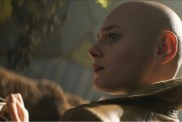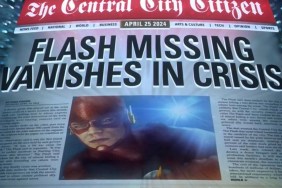“In the future, it’s a very dire situation for the X-Men.”

Twentieth Century Fox isn’t hiding the Sentinels either. Director Bryan Singer released the first image of the practical Sentinel on his Twitter feed, and then the viral marketing for Trask Industries started showing off how the robots had been used throughout history, including being present for Ronald Reagan’s Presidential inauguration. But what makes what they’re doing here different from the countless other robot films that we’ve seen in the past five years?
“There are movies like ‘Transformers,’ and ‘Iron Man,’ and ‘Pacific Rim,’ that have already explored robots of all different sizes and shapes and scope and caliber,” Singer said. “I knew that to make another robot attacks people or hero movie is not (ideal) – yet they are an element in the picture. So they serve the story in an interesting move, and not necessarily in an obvious rock-em-sock-em battle robots at the end of the movie kind of way, although there is some of that now that I’m really thinking about it. Come to think of it, more than I probably realize. It’s just not that, particular what you saw in that picture, is not the totality of it. That’s not exactly the whole of the technological threat.”
Legacy Effects, the geniuses that designed and built the characters and props for the Iron Man films, Avatar, The Amazing Spider-Man and many more, came up with the designs for the Sentinels and even built the practical one used on set. During the design phase, the company came to Singer with a wide range of potential designs for the different parts of the robots.

You may have noticed the look for the Mark 1 Sentinel looks a little glossier than normal, and maybe not exactly made out of metal. Well, you’re correct. The stylization of the Mark 1 was designed to reflect both the era of their creation (1973) as well as give them proper function against, say, mutants that can control metal.
“Well, we tried to make the Sentinels of the past a little fun and stylish but also a little retro,” Singer mentioned. “And the key is they’re not made of metal. That’s very important to our story because we’ve got a very powerful mutant. So that was a challenge to, to make them look like they could be made of polymer or some other material, plastic or something, but still have them be formidable when flying around and all that.”
X-Men: Days of Future Past also has the distinction of being the only “X-Men” film shot in 3D (2013’s The Wolverine was post-converted). It also marks Singer’s second outing with a 3D film, with his previous film Jack the Giant Slayer being his first go at the format, and he’s already changed out he approaches the material from that film.
“I became so captivated and caught up with the framing for the 3D that I didn’t shoot as aggressively as I had in my previous action/adventure films,” Singer revealed about working on Jack the Giant Slayer. “I wasn’t giving my editor the volume of material, he complained tremendously about it that I wasn’t giving him the coverage.”
“We’re looking at this differently,” Lauren Shuler Donner added. “In Bryan’s last movie I know he only watched the 3D monitor and focused on that. This time now he’ll go check all the time, but he’s also now focusing more on the characters and you can only do that really in 2D, because you can either watch the frame and how its going or as a director you can look at your actors which is what it’s all about.”

“Today is a very rare day where I’m shooting 2D because you can’t get the cameras, lenses, and rigs in the jet, but normally, we did an intimate scene in that jet that follows this scene where I actually forced the 3D cameras into the space. So this is rare, normally we’d be shooting native stereo.”
Special effects have been key for bringing the X-Men to life, but none of them have had quite this level of special effects. All told, producer Hutch Parker tells us it would be a safe bet there will be over one thousand effect shots in the completed film.








